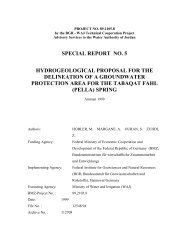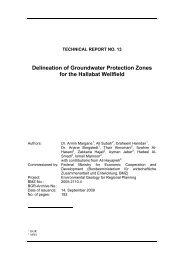best management practices for efficient water use in high rise and ...
best management practices for efficient water use in high rise and ...
best management practices for efficient water use in high rise and ...
Create successful ePaper yourself
Turn your PDF publications into a flip-book with our unique Google optimized e-Paper software.
Prevention of backflow <strong>and</strong> siphonage<br />
<strong>in</strong>to either <strong>water</strong> supply system.<br />
Provide <strong>in</strong>-build<strong>in</strong>g treatment plants to produce<br />
<strong>high</strong>-quality recycled <strong>water</strong> <strong>for</strong> non-potable <strong>use</strong>s<br />
with<strong>in</strong> the build<strong>in</strong>g if the construction of satellite<br />
treatment plant isn’t feasible.<br />
Provide dual-plumbed <strong>in</strong>frastructure <strong>for</strong> <strong>water</strong><br />
distribution <strong>in</strong> newly proposed future developments.<br />
Institute <strong>and</strong> run tra<strong>in</strong><strong>in</strong>g programs <strong>for</strong> operators of<br />
<strong>water</strong> reclamation facilities to staff future satellite<br />
<strong>water</strong> reclamation plants <strong>and</strong> <strong>in</strong>-build<strong>in</strong>g <strong>water</strong><br />
recycl<strong>in</strong>g facilities.<br />
Publish guidance booklets <strong>and</strong> brochures <strong>for</strong> <strong>use</strong><br />
by treatment plant operators <strong>and</strong> site supervisors.<br />
Storm Water Capture <strong>and</strong> Re<strong>use</strong>:<br />
Captured storm<strong>water</strong> may be <strong>use</strong>d <strong>for</strong> l<strong>and</strong>scape<br />
irrigation <strong>and</strong> to supplement recycled <strong>water</strong><br />
supplies. Ra<strong>in</strong>fall <strong>and</strong> resultant storm<strong>water</strong> may be<br />
captured by: collect<strong>in</strong>g runoff from roofs <strong>and</strong><br />
build<strong>in</strong>gs, divert<strong>in</strong>g surface flows <strong>in</strong>to catchment<br />
bas<strong>in</strong>s, remov<strong>in</strong>g debris <strong>and</strong> stor<strong>in</strong>g <strong>water</strong> <strong>in</strong> tanks.<br />
Conservation Manager<br />
Appo<strong>in</strong>t <strong>water</strong> conservation manager with the<br />
follow<strong>in</strong>g responsibilities <strong>and</strong> duties:<br />
Coord<strong>in</strong>ation <strong>and</strong> oversight of conservation<br />
programs <strong>and</strong> BMP implementation.<br />
Def<strong>in</strong>e <strong>and</strong> quantify the potential <strong>water</strong><br />
efficiency sav<strong>in</strong>gs.<br />
Create programs that deliver <strong>water</strong> <strong>efficient</strong><br />
measures.<br />
Communication <strong>and</strong> promotion of <strong>water</strong><br />
conservation; preparation of annual<br />
conservation budget; participation with<br />
other organizations to achieve <strong>water</strong><br />
efficiency goals; <strong>and</strong> preparation of the<br />
conservation elements of the agency’s<br />
Water Conservation Plan.<br />
Evaluate program progress <strong>and</strong> make<br />
appropriate changes to program activities.<br />
Report achievements of the program to<br />
<strong>management</strong> <strong>and</strong> the target audiences.<br />
Public In<strong>for</strong>mation BMP<br />
Design<strong>in</strong>g public <strong>in</strong><strong>for</strong>mation activities should<br />
consider the objectives of the <strong>water</strong> conservation<br />
ef<strong>for</strong>t <strong>and</strong> be carefully planned. The overall process<br />
is described <strong>in</strong> the follow<strong>in</strong>g steps:<br />
Frame the problem – focus on issues <strong>and</strong><br />
boundaries, describe the project need.<br />
Identify constra<strong>in</strong>ts – determ<strong>in</strong>e issues to<br />
be negotiated with the public <strong>and</strong> those that<br />
cannot, such as regulatory or political<br />
m<strong>and</strong>ates, spend<strong>in</strong>g limits.<br />
Identify <strong>and</strong> describe decision steps <strong>and</strong><br />
project milestones – develop a schedule<br />
that shows public <strong>in</strong>put decision po<strong>in</strong>ts.<br />
Identify <strong>and</strong> underst<strong>and</strong> potentially affected<br />
stakeholders – identify the groups that<br />
should be <strong>in</strong>volved.<br />
Determ<strong>in</strong>e vulnerability <strong>and</strong> must-resolve<br />
issues- focus ef<strong>for</strong>ts on issues <strong>and</strong> groups<br />
likely to generate the most conflict.<br />
Determ<strong>in</strong>e the appropriate level of public<br />
<strong>in</strong>volvement – establish what level of<br />
<strong>in</strong>volvement is needed to address<br />
stakeholder concerns.<br />
Select processes <strong>and</strong> techniques – by<br />
complet<strong>in</strong>g the above six steps first, the<br />
agency can save time <strong>and</strong> money by<br />
select<strong>in</strong>g from many available techniques.<br />
Develop a public <strong>in</strong>volvement work plan.<br />
Implement <strong>and</strong> monitor the work plan–<br />
periodic monitor<strong>in</strong>g is needed to ensure<br />
that the time frame has not changed.<br />
Manage change- the process must be<br />
flexible enough to adapt to changes <strong>in</strong><br />
schedule, political climate, staff or critical<br />
issues.<br />
Identify target audiences.<br />
Utilize effective consensus build<strong>in</strong>g<br />
techniques.<br />
Meter<strong>in</strong>g all Customers<br />
Meter all <strong>water</strong> sources, potable <strong>and</strong> non-potable,<br />
piped or tanker delivered.<br />
Install separate meters or sub-meters <strong>for</strong> <strong>in</strong>dividual<br />
leased, rented, or other tenant or sub-tenant space<br />
with<strong>in</strong> all commercial <strong>and</strong> residential build<strong>in</strong>gs.<br />
Frequently provide current <strong>water</strong> <strong>use</strong> data to<br />
customers <strong>and</strong> tenants. Bill tenants based on<br />
volume of <strong>water</strong> consumed. Connect meters <strong>and</strong><br />
sub-meters to a central data system where<br />
warranted.<br />
Install sub-meters on major <strong>water</strong> us<strong>in</strong>g equipment<br />
so leaks <strong>and</strong> other malfunctions may be identified.<br />
Submeter locations may <strong>in</strong>clude: laundry<br />
operations, swimm<strong>in</strong>g pools, food service &<br />
kitchens, irrigation systems, boiler makeup <strong>water</strong>,<br />
feed <strong>water</strong> to hot <strong>water</strong> boilers, separate <strong>water</strong><br />
heat<strong>in</strong>g systems, condensate return l<strong>in</strong>es to boilers<br />
makeup <strong>and</strong> blowdown <strong>water</strong> to all cool<strong>in</strong>g towers<br />
<strong>and</strong> other large <strong>water</strong> us<strong>in</strong>g equipment or process.<br />
Water Waste Prohibition<br />
Implement the recently developed Water Dem<strong>and</strong><br />
Management Policy <strong>in</strong> Jordan which prohibits <strong>water</strong><br />
resources from be<strong>in</strong>g wasted.<br />
Conservation Pric<strong>in</strong>g







